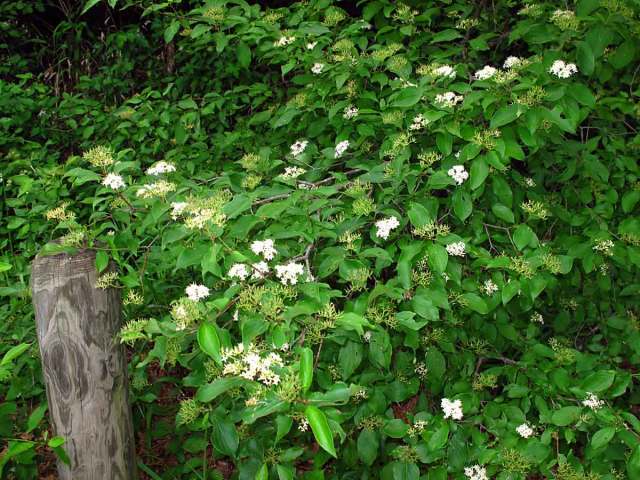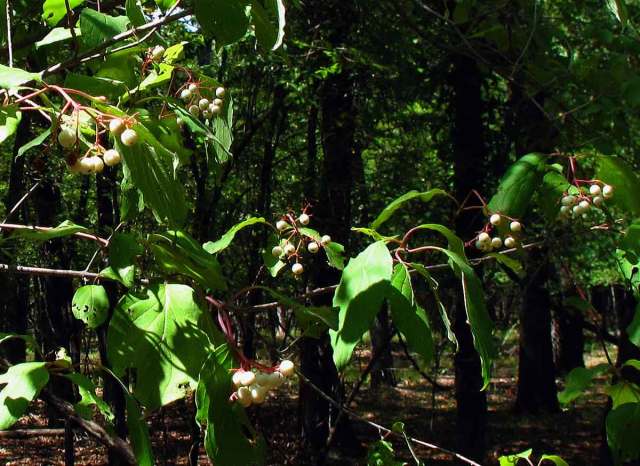If you live in East Texas and someone says the Dogwoods are blooming, you think of the Flowering Dogwood (Cornus florida). However if you live in North Central Texas, you immediately think of the Roughleaf Dogwood (Cornus drummondii) which brightens up the landscape at the Ft. Worth Nature Center & Refuge(a 3500+ acre oasis of varied habitats just west of Ft. Worth proper).
Be sure to click on the photos for better looks.
Roughleaf dogwood – Cornus drummondii
 May 10, 2009
May 10, 2009
Ft. worth Nature Center
Rough-leaf dogwood is a clumping shrub or small tree, to 16-18 ft. which does well in the understory, at margins or in fence rows. It is crowned with flat-topped clusters of creamy-yellow flowers and later has small white fruit. Leaves are opposite on green twigs and up to 4 inches long, roughly ovate with an abruptly drawn-out tip and a rounded to tapering base, smooth margins, and prominent veins bending toward the tip; upper surface sometimes slightly rough to the touch, lower slightly velvety. The upper surface of the oval leaves is covered with rough hairs while the lower surface is softly pubescent. Fall color is purplish-red. Flowers about 1/4 inch wide, cream colored, with 4 petals, numerous in broad clusters at the ends of branches, appearing from April to early June. The round white fleshy fruit is about 1/4 inch in size.
This dogwood is easily recognized by the rough, upper leaf surfaces and white fruit. It spreads from root sprouts and provides cover for wildlife and various small birds which nest in the thickets, as well as food for many small birds.
The species name of this plant is named for Thomas Drummond, (ca. 1790-1835), naturalist, born in Scotland, around 1790. In 1830 he made a trip to America to collect specimens from the western and southern United States. In March, 1833, he arrived at Velasco, Texas to begin his collecting work in that area. He spent twenty-one months working the area between Galveston Island and the Edwards Plateau, especially along the Brazos, Colorado, and Guadalupe rivers. His collections were some of the first made in Texas that were extensively distributed among the museums and scientific institutions of the world. He collected 750 species of plants and 150 specimens of birds. Drummond had hoped to make a complete botanical survey of Texas, but he died in Havana, Cuba, in 1835, under curious circumstances while presumable making a collecting tour of that island.
This tree does not have the large beautiful white blossoms of the flowering dogwood (Cornus florida). The rough-leaf dogwood (C. drummondii) has tiny individual creamy-white flowers which are in clusters that give an illusion of large blooms two – four inches across.
Roughleaf dogwood occurs over most of the Edwards Plateau, Central Texas. North Central Texas and southern East Texas, with a few growing in the Panhandle. Judging from its Texas range, rough-leaf dogwood tolerates a wide variety of soil types. It forms thickets by sprouting from spreading lateral roots.
Distribution of Roughleaf Dogwood

USDA, NRCS. 2009. The PLANTS Database . National Plant Data Center, Baton Rouge, LA 70874-4490 USA.
Cornus drummondii C.A. Mey.
Roughleaf dogwood
Cornaceae (Dogwood Family)
USDA Symbol: CODR
USDA Native Status: Native to U.S.
Leave a comment if you like trees.
Troy




Do you ever play magic tricks with dogwood leaves? On the trail hikes I lead we almost always come across some dogwood trees. I take a leaf from the tree and tell the kids I am going to perform a magic trick. I begin folding the leaf in half (point to point) back and forth several times until I have suffcient crease. Then I gently begin tearing the leaf from both sides towards the mid-vein. There is a filament within the leaf that is next to invisible and the leaf will appear to be floating in two pieces with nothing holding the bottom piece in place. The kids love it!